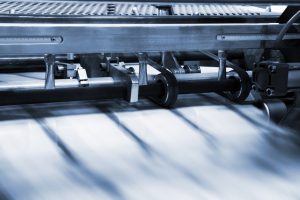 Offset printing is a printing service, during which the ink is applied indirectly from a roller, rather than being applied directly from the printing plate to the material. Without this process, printing of large amounts of paper would be impossible. Although many materials have gone digital, the offset printing process is still widely used, and this article takes a closer look at the evolution and uses of the offset printing process.
Offset printing is a printing service, during which the ink is applied indirectly from a roller, rather than being applied directly from the printing plate to the material. Without this process, printing of large amounts of paper would be impossible. Although many materials have gone digital, the offset printing process is still widely used, and this article takes a closer look at the evolution and uses of the offset printing process.
How Was the Offset Printing Process Created?
In the 18th century, the inventor of the lithography printing technique, Alois Senefelder, was researching a more cost-effective method of copying music sheets. Using high pressure forms made from limestone, he covered the sections that he wanted printed with a fatty printing-ink while the areas that were to remain blank were marked with a slightly acidic solution. After being moistened with water, the fatty printing-ink areas were dyed, while the acidic solution left the remainder of the space blank. The creation of this method signified an important milestone in the world of flat printing.
In 1904, the first prototypes of offset printing machines were constructed. Ira Washington Rubel and Caspar Hermann mirrored the indirect printing process with a rubber blanket cylinder on the sheet of paper. The first offset printing machine was presented to the public in 1912.
How Does the Offset Printing Process Work?
Offset printing technology is used to produce a high quality print in high amounts. The indirect process involves a cylinder covered with a rubber blanket being set up between the printing plate and the paper. In doing this, the printing ink is transferred indirectly on the sheet. Additionally, millimeter-thin aluminium plates are used as the print template instead of stone like the lithography process uses.
Before the offset printing process begins, a printing plate is constructed to be used with each ink, meaning there is a total of four plates for the four primary printing colors. The image surfaces are placed on the printing plate to later be filled with ink or kept blank to create the image. Because of this, color is only printed where it is intended to.
Without offset printing, the printing of things like brochures and signs in mass quantities would be very difficult and time consuming. These things are very important contributors to the success and reputation of a business. If a customer lives within a five mile radius of a business, they’re likely to see a that business’ signage between 50 and 60 times every month. With that in mind, it’s easy to see that printing high quality materials is instrumental in today’s world. Offset printing has developed over time to become a massive contribution to the increased efficiency of the printing process.
